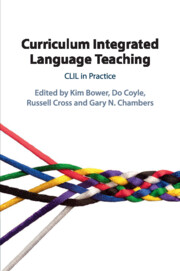Book contents
- Curriculum Integrated Language Teaching
- Curriculum Integrated Language Teaching
- Copyright page
- Contents
- Figures
- Tables
- Contributors
- Foreword
- Preface
- Acknowledgements
- Part I The Educational Context for CLIL
- Part II Current Aspects of Practice in CLIL
- 4 What Pupils Say about Transition (KS2–3) and What This Might Mean for CLIL
- 5 Diversity and Transnationalism
- 6 Three Schools, Three Models
- 7 Plurilingualism in the Content and Language Integrated Classroom
- Part III New Knowledge and Future Directions
- Afterword
- Index
- References
4 - What Pupils Say about Transition (KS2–3) and What This Might Mean for CLIL
from Part II - Current Aspects of Practice in CLIL
Published online by Cambridge University Press: 27 July 2020
- Curriculum Integrated Language Teaching
- Curriculum Integrated Language Teaching
- Copyright page
- Contents
- Figures
- Tables
- Contributors
- Foreword
- Preface
- Acknowledgements
- Part I The Educational Context for CLIL
- Part II Current Aspects of Practice in CLIL
- 4 What Pupils Say about Transition (KS2–3) and What This Might Mean for CLIL
- 5 Diversity and Transnationalism
- 6 Three Schools, Three Models
- 7 Plurilingualism in the Content and Language Integrated Classroom
- Part III New Knowledge and Future Directions
- Afterword
- Index
- References
Summary
This chapter addresses the following questions:
Why is transition important?
What factors need to be taken into account when considering CLIL and transition?
The proposed answers are informed by research carried out in the north of England and in Saxony-Anhalt in Germany, which gave the learners, the key stakeholders, a voice.
Research on foreign language teaching in primary schools from the 1960s to more recent times identifies transition from primary school to secondary school in this subject area as a problematic issue. CLIL, as a possible solution to the problems associated with transition, is not without its challenges. However, these are challenges worth confronting. CLIL gives real meaning to learning a foreign language and offers learners the opportunity to combine foreign language learning with the learning of other subjects. This facilitates the exploitation of the limited space on the school timetable – the primary school timetable in particular.
- Type
- Chapter
- Information
- Curriculum Integrated Language TeachingCLIL in Practice, pp. 63 - 92Publisher: Cambridge University PressPrint publication year: 2020



